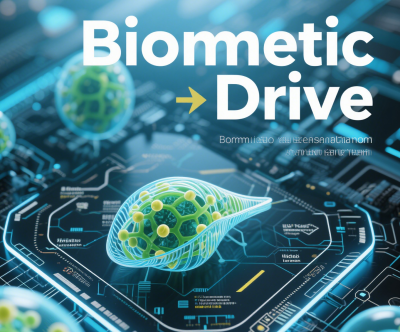
BiomimeticDrive: Definition and Multidimensional Analysis
BiomimeticDrive is a term combining Biomimetics (the study of imitating natural systems) and Drive (mechanical or energy transmission systems). It refers to bio-inspired drive technologies that replicate the structure, function, or material properties of biological systems to design efficient, adaptive, and sustainable mechanical or energy transmission systems. Below is a comprehensive analysis of its technical principles, applications, and scientific foundations:
I. Core Definition and Scope
- Literal Meaning:
- Biomimetics: Drawing inspiration from biological evolution to mimic natural forms, functions, or behaviors, such as bird flight, fish swimming, or plant photosynthesis.
- Drive: Engineering systems for mechanical transmission, energy conversion, or power delivery.
- Technical Essence:
- Nature-Inspired Design: Translating biological motion mechanisms (e.g., muscle contraction, joint coordination) into engineering models.
- Interdisciplinary Integration: Combines biology, materials science, mechanical engineering, and AI to create adaptive drive systems.
- Sustainability Goals: Mimics ecological energy cycles (e.g., photosynthesis) to reduce fossil fuel reliance.
II. Technical Principles and Biological Prototypes
- Biological Models and Engineering Translations:
Biological System Biomimetic Drive Technology Technical Principle Bird Flight Flapping-wing drones Aerodynamic optimization + flexible material deformation Fish Swimming Undulating propulsion underwater robots Muscle-spine motion simulation + fluid dynamics Plant Phototropism Solar tracker systems Light sensors + servo motor feedback control Insect Jumping Energy-storing robotic joints Elastin-inspired materials + energy release mechanisms - Key Technological Breakthroughs:
- Pneumatic Artificial Muscles (PAM): Mimics muscle contraction for soft robotics (e.g., octopus-inspired grippers).
- Spider Silk-Inspired Materials: Lightweight, high-strength components (e.g., gears) balancing toughness and flexibility.
- Photosynthetic Energy Systems: Solar-powered biomimetic leaves for self-sustaining energy conversion.
III. Applications and Case Studies
- Robotics:
- Case 1: Boston Dynamics’ Atlas Robot uses a leg drive system mimicking human tendon-bone elasticity for efficient jumping and balance.
- Case 2: Undulating-fin underwater robots reduce energy consumption by 40% compared to propellers.
- Renewable Energy:
- Case: Whale fin-inspired wind turbine blades reduce turbulence by 32%, boosting energy output by 15%.
- Medical Devices:
- Case: Biomimetic exoskeletons replicate human gait, improving mobility for paralyzed patients with 22% higher efficiency than traditional motors.
IV. Challenges and Future Directions
- Technical Bottlenecks:
- Dynamic Adaptability: Difficulty replicating biological environmental responsiveness (e.g., octopus tentacles grasping diverse objects).
- Material Durability: Fatigue failure in flexible biomimetic materials (e.g., hydrogel muscles under prolonged stress).
- Energy Efficiency: Natural systems (e.g., ATP synthesis) outperform current batteries or fuel cells.
- Future Innovations:
- AI-Biomimetic Synergy: Machine learning optimizes drive parameters (e.g., wing flapping frequency) for environmental adaptation.
- Quantum Biomaterials: Simulates molecular-level energy transfer (e.g., exciton transport in photosynthesis) via quantum tunneling.
- Bio-Hybrid Systems: Integrates living cells (e.g., cardiomyocytes) with mechanical structures for semi-biological drives.
V. Ethical and Ecological Impact
- Ecological Risks:
- Biomimetic underwater robots may disrupt marine ecosystems (e.g., mistaken for prey or competitors).
- Mass production of biomimetic materials risks introducing non-degradable nanopollutants.
- Ethical Concerns:
- Bio-mechanical hybrids raise questions about the use of neural cells to control robots.
- Military applications (e.g., insect-sized surveillance drones) could enable unethical warfare.
Conclusion
BiomimeticDrive exemplifies engineering’s deep dive into nature’s evolutionary wisdom, offering solutions to humanity’s challenges in energy efficiency, adaptability, and sustainability. Despite material, energy, and ethical hurdles, its applications in robotics, renewable energy, and healthcare demonstrate transformative potential. With advancements in AI and quantum technologies, biomimetic drive systems may become central to next-gen intelligent machinery, redefining humanity’s synergy with nature.
If you are interested in purchasing this domain, please contact: chuanchuan810@gmail.com





